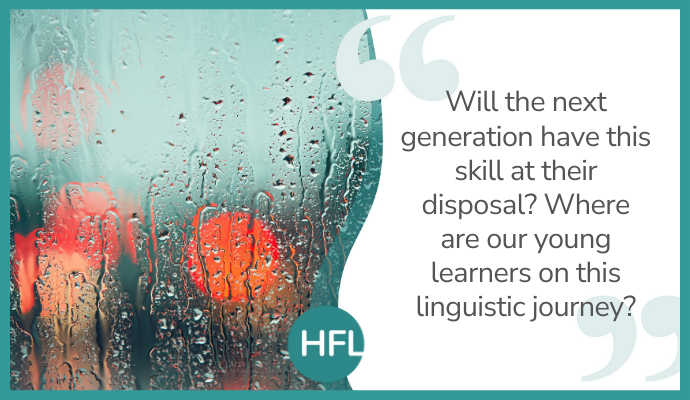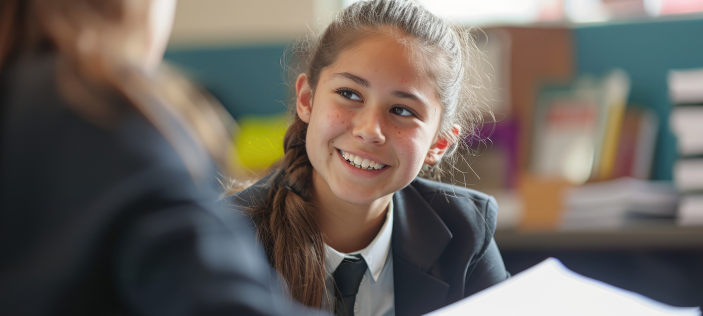
As I write, tucked up under a blanket with the fire resolutely off, the January rain is hammering on my roof and pouring down my windows in torrents. Let’s face it: the UK receives a famous amount of precipitation and we do like to wonder and complain about it, or even long for it when it disappears for long stretches. As an adult, I seem to have spent my life amassing different words and phrases to describe the weather in all its forms, but perhaps my greatest vocabulary bank is the one that supports the nuances of rain, enabling me to differentiate to any interested party between slight drizzle, a heavy shower or a torrential downpour. Will the next generation have this skill at their disposal? Where are our young learners on this linguistic journey?
Beyond the obligatory British weather conversation, it’s a given that a rich language store gives us confidence to articulate ourselves clearly and navigate our day-to day life. Furthermore, all educators know the importance of vocabulary in academic success. Many a study has focused on the correlation between language poverty and success at GCSE level. Pupils can lack broad enough general vocabulary for written communication as well as the technical, subject specific terminology needed to fully access the whole curriculum. The vocabulary gap is insidious, getting its claws into many children at an early age and breeding educational disadvantage from the outset. Without multiple word keys at their disposal, word-poor children cannot unlock further vocabulary. So begins what is commonly termed ‘The Matthew Effect’ of the word rich getting richer, the word poor getting poorer, and the vocabulary gap getting wider.
Systematic vocabulary instruction
That gap was already a chasm for some, but the pandemic has exacerbated the issue. Lockdowns meant limited opportunities for under-fives to socialise at a vital stage of language development. Many of our young children are therefore arriving in school with a depleted lexicon, which impacts communication skills as well as early reading development. Children will naturally build language as they interact with the world around them and absorb new experiences. However, for most, this won’t be enough and direct instruction is also key: we need to give children opportunities to learn new vocabulary through activities that help them play, explore, classify, categorise, compare, contrast, detect patterns and construct meaning.
Most schools have, over the last decade or more, built in an element of vocabulary instruction in reading, writing and spoken language activities. Many schools have devised systematic approaches and programmes of study. However, the rate at which children accrue new language doesn’t always match the urgency of the disadvantage some pupils have in this area. Whether this be the ‘30-million-word gap’ cited almost thirty years ago by Hart and Risley (Meaningful Differences in the Everyday Experiences of Young Children) or a more conservative figure, the scale of the problem is undeniable.
Bringing words (back) to life
In 2002, Beck, McKeown and Kucan brought us the book Bringing Words to Life, an indispensable guide to primary practitioners which introduced us to the concept of 3 tiers of vocabulary. These tiers are now part of our teaching vernacular, explaining how we might classify words in terms of difficulty and frequency, with Tier One being everyday core words for naming nouns, actions and so on; Tier Two being alternative words for Tier One and Tier Three comprising technical vocabulary, context specific words that are peculiar to a specific subject. Using my weather theme as an illustration we might have
- Tier 1: rain
- Tier 2: drizzle, shower, precipitation
- Tier 3: relief, frontal and convectional rainfall (and yes, I had to look these up)
If we assume that children will pick up the simple naming terms from everyday communications, and accept that we will probably need to explicitly teach most tier 3 words as and when they crop up, that leaves us with a raft of tier two words to teach. These are typically synonyms of words we already know, pertaining to concepts we already understand. Tier two comprises the literary language that adds breadth and depth to our word store as it seeks to evoke a more specific idea, create a precise image as well as keep our minds active and engaged. These are the words that they will be able to apply in a variety of contexts- words that will enrich their reading comprehension as well as writing composition. Words that build their knowledge and understanding of the world. This is where we place our focus.
Vocabulary activities to try out
Sticking with my weather theme, here are a few wintery ideas designed to build upon children’s Tier Two vocabulary:
- A graphic of a thermometer adding words rather than figures will help children to articulate the nuances of how warm or cold they feel: plot out boiling and freezing and encourage pupils to discover and order words and phrases to fit in between these extremes. Include less formal words and idiomatic expressions such as ‘a bit nippy’ or ‘stone cold’. Are there any regional phrases that are commonly used in your area? ‘Taters’ and ‘brass monkeys’ were used in my childhood.
- In the lead up to Christmas we ran a Twitter campaign entitled #WinterWonderWords, which explored the etymology of some seasonal language and provided activities that could be done based on each of the featured words. These wintery words still feel relevant this side of the festivities, and might be used as five-minute activities to spark word awareness.
Winter Wonder Words (pdf) - As well as through explicit teaching of specific words and phrases, much of our vocabulary learning can also be acquired through indirect life experiences. Arguably the most powerful of these is reading. The world of literature gives us access to a vast storehouse of words. Through broad, deep and frequent reading we build our knowledge of the unfamiliar, including the expansion of our vocabulary in the context - and upon the foundations- of the language we already know. Consider creating a wall of seasonal literary quotes. I have included a few of my favourites but you’ll have more of your own, I’m sure.
Wintery quotes (pptx)
Ask the children to imagine each word costs £1 and you have given them £10. Which words and/ or phrases would they choose to buy? Why? - Can the children ‘magpie’ words and phrases to use in their own writing? Setting descriptions are a great way to encourage children to paint a picture with words- to bring an image to life. Describe a familiar location such as the school grounds, a local park, a riverside, a balcony in summer and then contrast with a description of the same place in winter.






